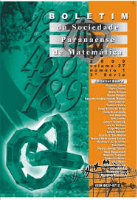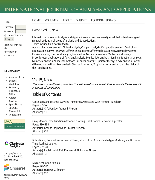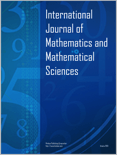
Korean Journal of Mathematics
Scope & Guideline
Elevating the Standards of Mathematical Scholarship.
Introduction
Aims and Scopes
- Pure Mathematics:
Focus on foundational aspects of mathematics, including algebra, geometry, topology, and analysis. Research in this area often explores abstract concepts and seeks to establish new theoretical frameworks. - Applied Mathematics:
Emphasis on the application of mathematical methods and theories to solve real-world problems. This includes areas such as mathematical modeling, numerical analysis, and optimization. - Statistics and Probability:
Research related to statistical methods, probability theory, and their applications in various fields. This area includes studies on statistical convergence, estimation, and data analysis techniques. - Mathematical Physics:
Interdisciplinary studies that apply mathematical techniques to problems in physics, including the exploration of mathematical structures that underpin physical theories. - Computational Mathematics:
Research that focuses on algorithms, numerical simulations, and computational techniques. This area addresses practical computational issues and the development of new numerical methods. - Geometry and Topology:
Exploration of geometric structures, topological spaces, and their properties. This includes studies on manifolds, curvature, and the relationships between different geometric objects. - Fixed Point Theory:
Investigation of fixed point theorems and their applications in various mathematical contexts. This includes studies on mappings in metric spaces and their convergence properties.
Trending and Emerging
- Fractional Calculus and Inequalities:
There is a growing interest in fractional calculus and its applications, particularly in establishing new inequalities and exploring their implications in diverse mathematical contexts. - Fuzzy Mathematics and Soft Computing:
Research involving fuzzy sets and soft computing techniques has gained traction, indicating an increasing recognition of their relevance in dealing with uncertainty and imprecision in mathematical modeling. - Nonlinear Dynamics and Chaos Theory:
Studies focusing on nonlinear systems and chaos theory are on the rise, reflecting a broader interest in understanding complex systems and their behaviors. - Computational Methods in Algebra and Geometry:
The application of computational techniques to solve algebraic and geometric problems is trending, showcasing the integration of technology with traditional mathematical disciplines. - Topological Data Analysis:
Emerging interest in topological data analysis reflects a trend towards utilizing topological concepts to analyze and interpret data, indicating a shift towards data-driven mathematical research. - Mathematical Biology and Population Dynamics:
Research that applies mathematical modeling to biological systems, particularly in population genetics and dynamics, is increasingly prominent, highlighting the interdisciplinary nature of contemporary mathematical research.
Declining or Waning
- Classical Analysis Techniques:
Traditional methods of analysis, such as those focused on classical inequalities and basic function properties, have become less prevalent as researchers explore more modern and complex analytical techniques. - Elementary Number Theory:
Research articles concentrating on basic aspects of number theory, such as divisibility and prime numbers, have decreased in frequency, suggesting a shift towards more advanced or applied number theory. - Basic Algebraic Structures:
Studies centered on elementary algebraic concepts, such as simple ring theory and basic group theory, have waned as the journal increasingly emphasizes more complex algebraic structures and their applications. - Static Mathematical Models:
There is a noticeable reduction in publications focusing on static models without consideration for dynamic systems or real-time applications, as the field moves towards more dynamic and computational approaches. - Traditional Combinatorics:
Classic combinatorial techniques and problems have seen a decline as the journal pivots toward more interdisciplinary approaches that integrate combinatorial methods with other mathematical domains.
Similar Journals

Boletim Sociedade Paranaense de Matematica
Connecting Minds Through Mathematical ExcellenceBoletim Sociedade Paranaense de Matematica is a distinguished journal within the field of Mathematics, published by the Sociedade Paranaense de Matemática in Brazil. With an ISSN of 0037-8712 and an E-ISSN of 2175-1188, this journal has been committed to fostering open access to mathematical research since 2002, ensuring that cutting-edge research is readily available to the academic community. Operating within the diverse landscape of mathematical studies and ranked Q3 for 2023 in the category of Mathematics (Miscellaneous), the journal serves as a platform for innovative contributions and discussions. It ranks 192nd out of 399 in the Scopus database for General Mathematics, reflecting its steady involvement in the global academic dialogue. The Boletim resides at JD AMERICAS, CAIXA POSTAL 19081, CURITIBA PR 81531-990, Brazil, and aims to connect researchers, practitioners, and students by promoting high-quality research and dissemination of mathematical knowledge. By bridging diverse mathematical theories and applications, the journal not only enhances understanding of the discipline but also drives future research directions.

International Journal of Analysis and Applications
Exploring the intersections of mathematics and management.International Journal of Analysis and Applications, published by ETAMATHS PUBL, is a premier open-access journal dedicated to fostering advancements in the fields of analysis, applied mathematics, geometry, topology, and their applications in business and international management. With a commitment to providing high-quality research, the journal has been an open-access platform since 2013, ensuring that researchers, professionals, and students have unhindered access to valuable findings and methodologies. Based in Vancouver, Canada, the journal’s scope spans a diverse range of mathematical disciplines, bridging theoretical concepts with practical applications. The journal has been categorized in various quartiles as of 2023, reaching Q4 in Analysis and Applied Mathematics, and Q3 in Business and International Management, highlighting its growing importance in the academic community. At present, it is ranked 55th in Geometry and Topology and holds a respectable position within the Scopus database. By fostering innovative research and providing a collaborative platform, the International Journal of Analysis and Applications aims to contribute significantly to the development and application of mathematical theory in contemporary settings.

Fixed Point Theory
Elevating Understanding of Fixed Point DynamicsFixed Point Theory, published by HOUSE BOOK SCIENCE-CASA CARTII STIINTA, is a distinguished journal that has garnered attention in the fields of mathematical analysis, applied mathematics, and computational mathematics. With an ISSN of 1583-5022 and an E-ISSN of 2066-9208, this journal serves as a vital platform for disseminating innovative research and significant developments in fixed point theory and its numerous applications. Its emergence as a Q3-ranked journal in 2023 across multiple categories indicates its growing influence within the academic community, particularly in Romania and beyond. Researchers, professionals, and students alike will find Fixed Point Theory an essential resource for staying abreast of the latest findings, methodologies, and theoretical advancements in these critical areas of mathematics, fostering a deeper understanding and stimulating further exploration in both foundational and applied settings.

JOURNAL OF THE KOREAN MATHEMATICAL SOCIETY
Pioneering research for a brighter mathematical future.JOURNAL OF THE KOREAN MATHEMATICAL SOCIETY is a premier academic publication dedicated to advancing the field of mathematics through rigorous research and scholarly discourse. Published by the esteemed Korean Mathematical Society, this journal provides a platform for mathematicians and researchers to disseminate their findings, engage in innovative ideas, and connect with the global mathematical community. With an ISSN of 0304-9914 and E-ISSN 2234-3008, the journal has established itself as an important resource in the mathematical landscape, currently holding a Q3 classification in the ‘Mathematics (miscellaneous)’ category as per the 2023 rankings. Though not open access, the journal is committed to promoting high-quality contributions that span various mathematical disciplines, making it indispensable for students, researchers, and professionals alike. Operating from its base in Seoul, South Korea, it contributes to the international mathematics community by publishing cutting-edge research from 1997 to 2024 and beyond, facilitating an avenue for knowledge sharing and innovation in mathematics.

Carpathian Journal of Mathematics
Connecting Scholars Through Rigorous Mathematical DiscourseCarpathian Journal of Mathematics, published by NORTH UNIV BAIA MARE in Romania, is an esteemed research platform dedicated to the diverse and evolving field of mathematics. With an impressive Q2 ranking in the 2023 Mathematics (miscellaneous) category, this journal serves as a vital resource for researchers and practitioners alike, offering insights into both theoretical and applied mathematics. Spanning from its inception in 2003 to the anticipated contributions in 2024, it has established itself as a reputable source with a significant impact, reflected in its Scopus rank of #84/399 in General Mathematics, positioning it in the 79th percentile. Although it operates without open access, the journal ensures that subscribers, institutions, and readers enjoy rigorous peer-reviewed content that pushes the boundaries of mathematical inquiry. From algebra and number theory to applied mathematics and mathematical modeling, the Carpathian Journal of Mathematics stands as a beacon for innovation and scholarly dialogue, catering to an audience eager to contribute to and learn from the mathematical sciences.

INTERNATIONAL JOURNAL OF MATHEMATICS AND MATHEMATICAL SCIENCES
Advancing mathematical frontiers since 1978.INTERNATIONAL JOURNAL OF MATHEMATICS AND MATHEMATICAL SCIENCES is a distinguished peer-reviewed journal published by HINDAWI LTD, dedicated to advancing the field of mathematics and its various applications. Since its inception in 1978, the journal has been committed to open access, ensuring that research is freely available to all, thereby fostering greater collaboration and dissemination of knowledge. With an impressive Q3 ranking in the Mathematics (miscellaneous) category and a notable Scopus rank in the 72nd percentile, this journal is a vital resource for researchers, professionals, and students. The journal covers a wide range of topics in mathematics, from theoretical explorations to applied methodologies, and it continues to serve as a platform for significant contributions in this evolving discipline. Its continuous publication from 1978 to present reflects its enduring relevance and impact in the mathematical sciences community.

Lobachevskii Journal of Mathematics
Pioneering Research for a Mathematical TomorrowLobachevskii Journal of Mathematics is a distinguished academic journal published by MAIK NAUKA/INTERPERIODICA/SPRINGER, dedicated to advancing research in the diverse field of mathematics. With an ISSN of 1995-0802 and an E-ISSN of 1818-9962, it has been a vital resource for scholars since its inception in 1999. Recognized for its contributions to the field, the journal proudly holds a Q2 ranking in the 2023 Mathematics (miscellaneous) category, placing it among the top half of its peers in Scopus, with a rank of 174 out of 399 and a 56th percentile standing. While currently not classified as an open-access journal, it effectively reaches a global audience through comprehensive dissemination of innovative mathematical research until 2024. Researchers, professionals, and students alike will find the Lobachevskii Journal a significant platform for the latest developments and theories in general mathematics, fostering an environment of scholarly exchange and growth.

Science China-Mathematics
Fostering Collaboration in Mathematical ExcellenceScience China-Mathematics, published by SCIENCE PRESS, is a premier peer-reviewed journal dedicated to the dissemination of significant new findings in the field of mathematics. With an ISSN of 1674-7283 and an E-ISSN of 1869-1862, this journal has established itself as a vital resource for researchers and professionals since its inception. Recognized in the Q1 category for Mathematics (miscellaneous) and holding an impressive rank of #75 out of 399 in the Scopus Mathematics General category (81st percentile), the journal showcases cutting-edge research and theoretical advancements. Committed to promoting open access, the journal ensures that high-quality mathematical research is accessible to global audiences, empowering researchers, students, and professionals. Spanning from 2010 to 2024, Science China-Mathematics plays a crucial role in the unification of mathematical knowledge and encourages collaboration across disciplines.

Revista de la Real Academia de Ciencias Exactas Fisicas y Naturales Serie A-Matematicas
Empowering the Future of Mathematics through Quality ScholarshipRevista de la Real Academia de Ciencias Exactas Fisicas y Naturales Serie A-Matematicas, published by SPRINGER-VERLAG ITALIA SRL, is a premier academic journal based in Italy that serves as a significant platform for researchers and practitioners in the fields of Mathematics. With a focus on core areas such as Algebra, Analysis, Applied Mathematics, Computational Mathematics, and Geometry and Topology, this journal boasts an impressive performance in academic rankings, achieving Q1 status in multiple categories, reflecting its excellence in disseminating high-quality research. The journal is easily accessible through subscription options and provides a vital resource for the mathematics community, fostering the exploration of innovative ideas and methodologies. The journal’s commitment to advancing mathematical knowledge is evident through its competitive Scopus rankings, including a remarkable rank of #1 in Algebra and Number Theory, placing it in the top percentile of its field. Scholars and students alike will find in this publication a rich source of impactful research that not only contributes to the academic discourse but also enhances the practical applications of mathematics in today's society.

Ukrainian Mathematical Journal
Exploring Diverse Mathematical LandscapesThe Ukrainian Mathematical Journal is a prominent academic publication in the field of mathematics, focusing on a diverse range of topics that appeal to researchers, professionals, and students alike. Published by Springer, this journal has been an important platform for disseminating significant mathematical research since its inception in 1957. With the aim of fostering knowledge and collaboration within the mathematical community, the journal curates high-quality articles that meet rigorous scholarly standards, evidenced by its Q3 ranking in the miscellaneous mathematics category for 2023. Although it currently does not offer open access, the journal remains accessible through various institutional subscriptions. It serves as a vital resource for ongoing discourse in the field and invites contributions that further advance mathematical understanding.